Management Accounting Report: Business Development at Unilever
VerifiedAdded on 2023/01/19
|24
|6018
|79
Report
AI Summary
This report provides a comprehensive overview of management accounting, focusing on its application within a business context, specifically using Unilever as a case study. It begins with an introduction to management accounting and its role in decision-making, emphasizing the importance of accurate financial management. The report then delves into various management accounting systems, including cost accounting, job costing, price optimization, and inventory management, evaluating their benefits and drawbacks. It also explains different methods used in management accounting reporting, such as budget reports, cost management accounting reports, and performance reports, highlighting their significance in measuring and improving business performance. The report further examines the application of management accounting techniques, including planning tools for budget preparation and forecasting, and analyzes how these techniques contribute to organizational success by addressing financial problems. The conclusion summarizes the key findings, emphasizing the critical role of management accounting in achieving sustainable business development and financial stability.
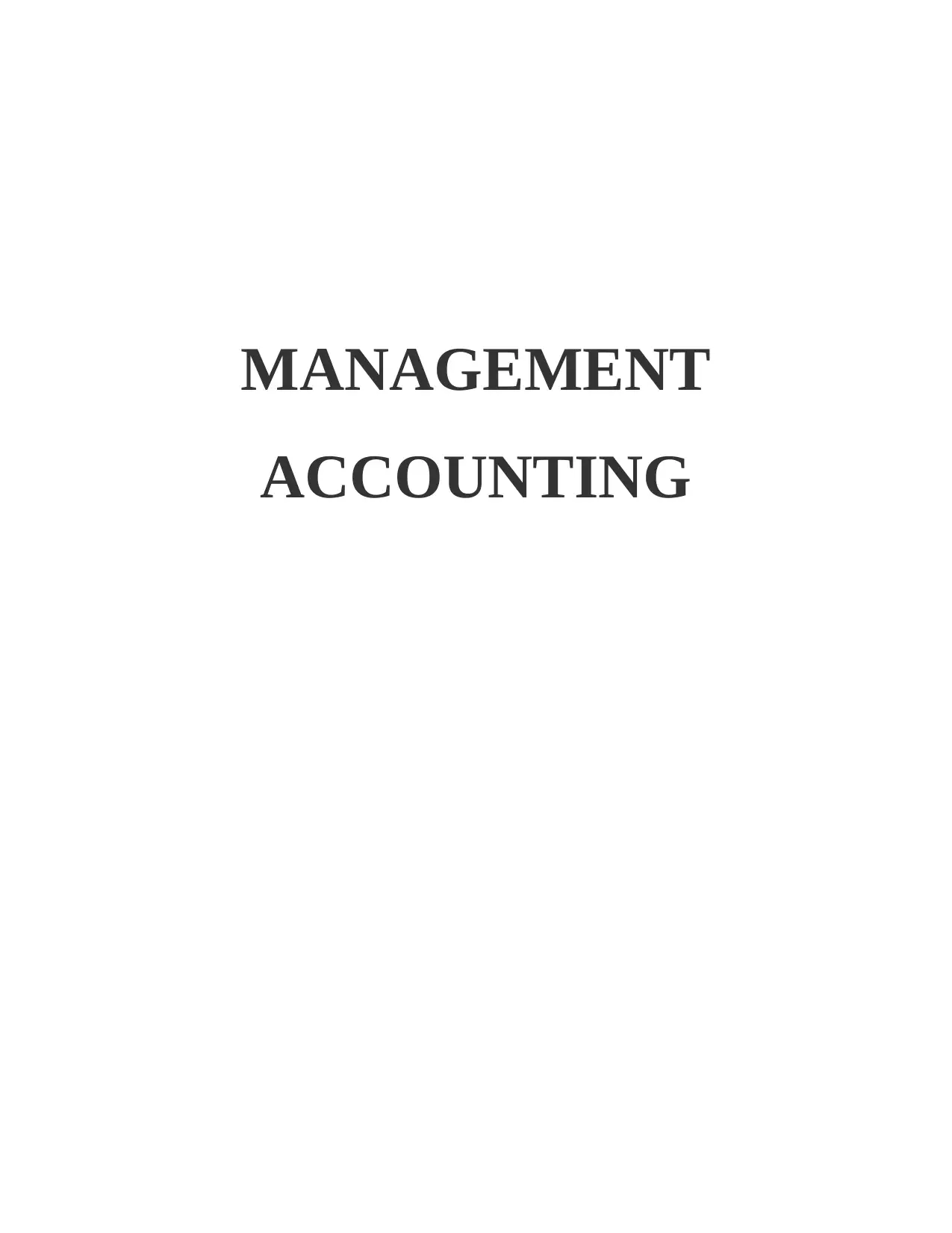
MANAGEMENT
ACCOUNTING
ACCOUNTING
Paraphrase This Document
Need a fresh take? Get an instant paraphrase of this document with our AI Paraphraser
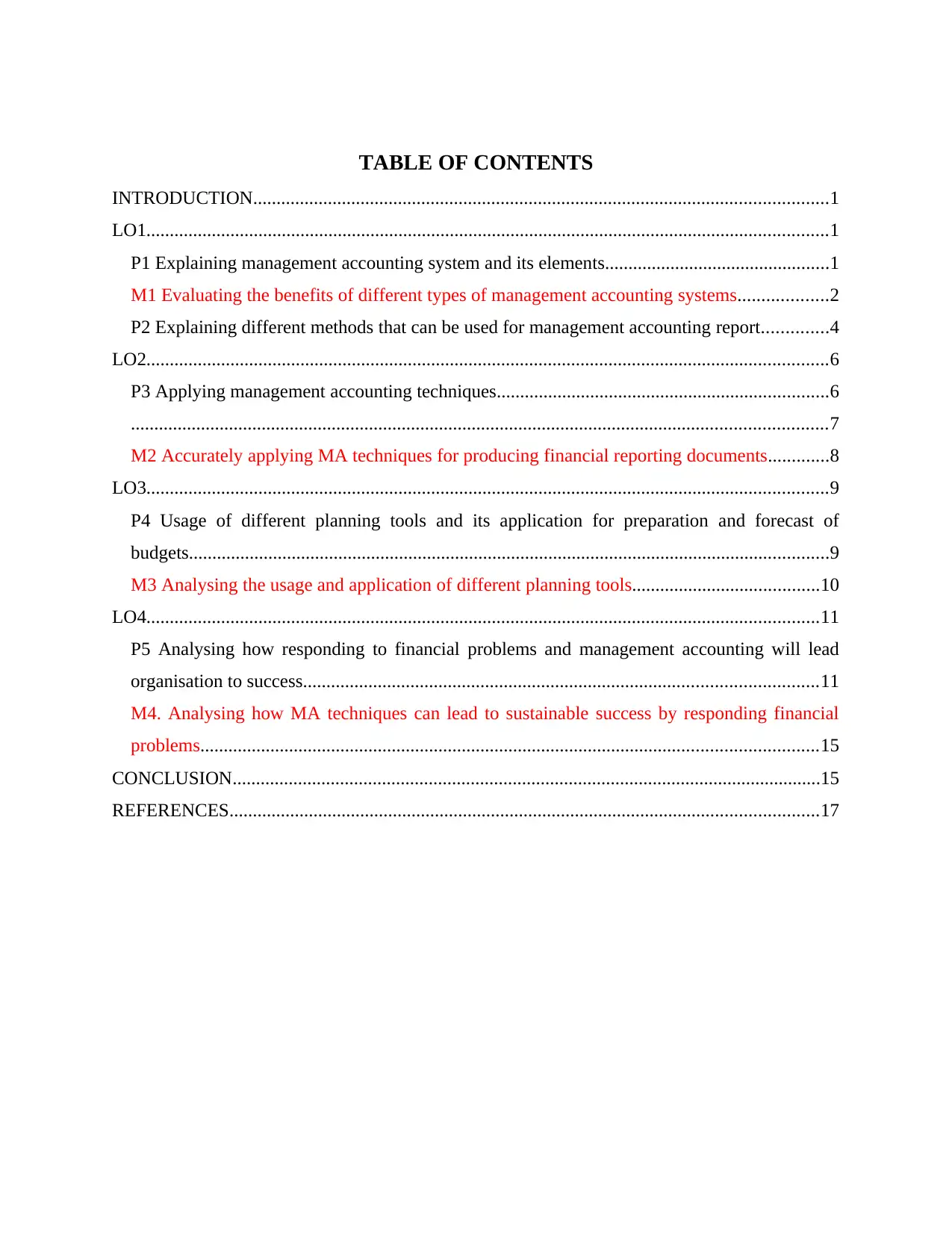
TABLE OF CONTENTS
INTRODUCTION...........................................................................................................................1
LO1..................................................................................................................................................1
P1 Explaining management accounting system and its elements................................................1
M1 Evaluating the benefits of different types of management accounting systems...................2
P2 Explaining different methods that can be used for management accounting report..............4
LO2..................................................................................................................................................6
P3 Applying management accounting techniques.......................................................................6
.....................................................................................................................................................7
M2 Accurately applying MA techniques for producing financial reporting documents.............8
LO3..................................................................................................................................................9
P4 Usage of different planning tools and its application for preparation and forecast of
budgets.........................................................................................................................................9
M3 Analysing the usage and application of different planning tools........................................10
LO4................................................................................................................................................11
P5 Analysing how responding to financial problems and management accounting will lead
organisation to success..............................................................................................................11
M4. Analysing how MA techniques can lead to sustainable success by responding financial
problems....................................................................................................................................15
CONCLUSION..............................................................................................................................15
REFERENCES..............................................................................................................................17
INTRODUCTION...........................................................................................................................1
LO1..................................................................................................................................................1
P1 Explaining management accounting system and its elements................................................1
M1 Evaluating the benefits of different types of management accounting systems...................2
P2 Explaining different methods that can be used for management accounting report..............4
LO2..................................................................................................................................................6
P3 Applying management accounting techniques.......................................................................6
.....................................................................................................................................................7
M2 Accurately applying MA techniques for producing financial reporting documents.............8
LO3..................................................................................................................................................9
P4 Usage of different planning tools and its application for preparation and forecast of
budgets.........................................................................................................................................9
M3 Analysing the usage and application of different planning tools........................................10
LO4................................................................................................................................................11
P5 Analysing how responding to financial problems and management accounting will lead
organisation to success..............................................................................................................11
M4. Analysing how MA techniques can lead to sustainable success by responding financial
problems....................................................................................................................................15
CONCLUSION..............................................................................................................................15
REFERENCES..............................................................................................................................17
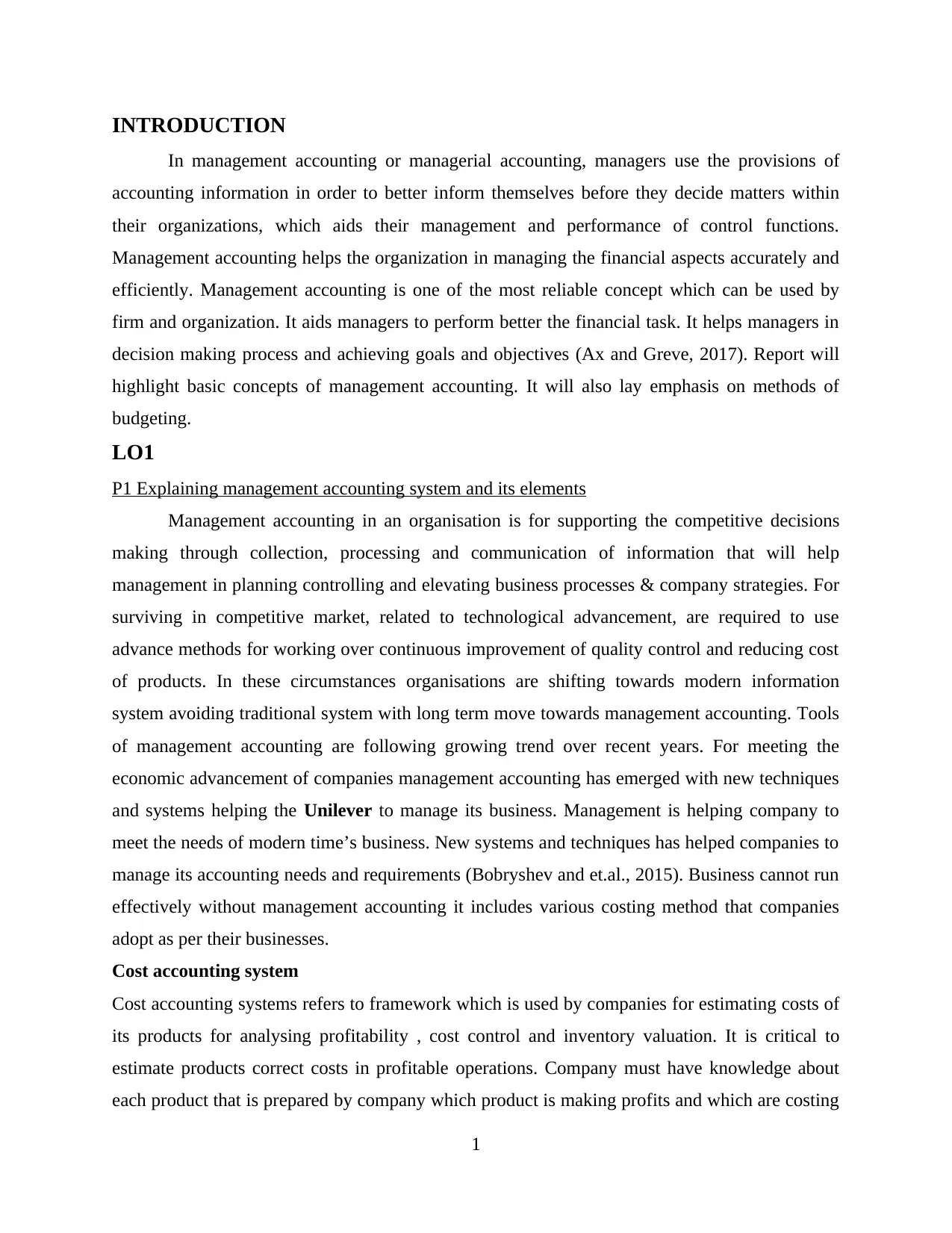
INTRODUCTION
In management accounting or managerial accounting, managers use the provisions of
accounting information in order to better inform themselves before they decide matters within
their organizations, which aids their management and performance of control functions.
Management accounting helps the organization in managing the financial aspects accurately and
efficiently. Management accounting is one of the most reliable concept which can be used by
firm and organization. It aids managers to perform better the financial task. It helps managers in
decision making process and achieving goals and objectives (Ax and Greve, 2017). Report will
highlight basic concepts of management accounting. It will also lay emphasis on methods of
budgeting.
LO1
P1 Explaining management accounting system and its elements
Management accounting in an organisation is for supporting the competitive decisions
making through collection, processing and communication of information that will help
management in planning controlling and elevating business processes & company strategies. For
surviving in competitive market, related to technological advancement, are required to use
advance methods for working over continuous improvement of quality control and reducing cost
of products. In these circumstances organisations are shifting towards modern information
system avoiding traditional system with long term move towards management accounting. Tools
of management accounting are following growing trend over recent years. For meeting the
economic advancement of companies management accounting has emerged with new techniques
and systems helping the Unilever to manage its business. Management is helping company to
meet the needs of modern time’s business. New systems and techniques has helped companies to
manage its accounting needs and requirements (Bobryshev and et.al., 2015). Business cannot run
effectively without management accounting it includes various costing method that companies
adopt as per their businesses.
Cost accounting system
Cost accounting systems refers to framework which is used by companies for estimating costs of
its products for analysing profitability , cost control and inventory valuation. It is critical to
estimate products correct costs in profitable operations. Company must have knowledge about
each product that is prepared by company which product is making profits and which are costing
1
In management accounting or managerial accounting, managers use the provisions of
accounting information in order to better inform themselves before they decide matters within
their organizations, which aids their management and performance of control functions.
Management accounting helps the organization in managing the financial aspects accurately and
efficiently. Management accounting is one of the most reliable concept which can be used by
firm and organization. It aids managers to perform better the financial task. It helps managers in
decision making process and achieving goals and objectives (Ax and Greve, 2017). Report will
highlight basic concepts of management accounting. It will also lay emphasis on methods of
budgeting.
LO1
P1 Explaining management accounting system and its elements
Management accounting in an organisation is for supporting the competitive decisions
making through collection, processing and communication of information that will help
management in planning controlling and elevating business processes & company strategies. For
surviving in competitive market, related to technological advancement, are required to use
advance methods for working over continuous improvement of quality control and reducing cost
of products. In these circumstances organisations are shifting towards modern information
system avoiding traditional system with long term move towards management accounting. Tools
of management accounting are following growing trend over recent years. For meeting the
economic advancement of companies management accounting has emerged with new techniques
and systems helping the Unilever to manage its business. Management is helping company to
meet the needs of modern time’s business. New systems and techniques has helped companies to
manage its accounting needs and requirements (Bobryshev and et.al., 2015). Business cannot run
effectively without management accounting it includes various costing method that companies
adopt as per their businesses.
Cost accounting system
Cost accounting systems refers to framework which is used by companies for estimating costs of
its products for analysing profitability , cost control and inventory valuation. It is critical to
estimate products correct costs in profitable operations. Company must have knowledge about
each product that is prepared by company which product is making profits and which are costing
1
⊘ This is a preview!⊘
Do you want full access?
Subscribe today to unlock all pages.

Trusted by 1+ million students worldwide
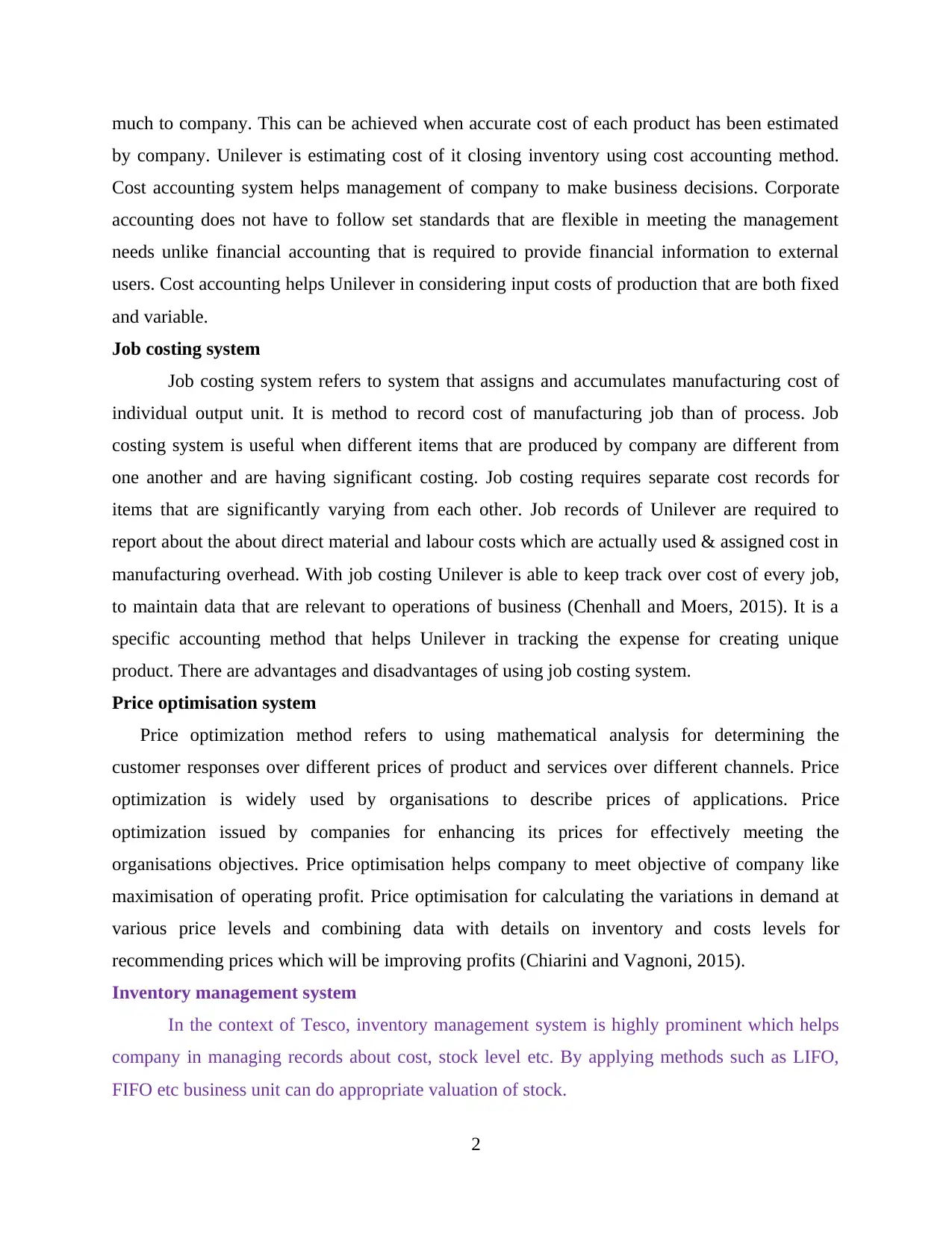
much to company. This can be achieved when accurate cost of each product has been estimated
by company. Unilever is estimating cost of it closing inventory using cost accounting method.
Cost accounting system helps management of company to make business decisions. Corporate
accounting does not have to follow set standards that are flexible in meeting the management
needs unlike financial accounting that is required to provide financial information to external
users. Cost accounting helps Unilever in considering input costs of production that are both fixed
and variable.
Job costing system
Job costing system refers to system that assigns and accumulates manufacturing cost of
individual output unit. It is method to record cost of manufacturing job than of process. Job
costing system is useful when different items that are produced by company are different from
one another and are having significant costing. Job costing requires separate cost records for
items that are significantly varying from each other. Job records of Unilever are required to
report about the about direct material and labour costs which are actually used & assigned cost in
manufacturing overhead. With job costing Unilever is able to keep track over cost of every job,
to maintain data that are relevant to operations of business (Chenhall and Moers, 2015). It is a
specific accounting method that helps Unilever in tracking the expense for creating unique
product. There are advantages and disadvantages of using job costing system.
Price optimisation system
Price optimization method refers to using mathematical analysis for determining the
customer responses over different prices of product and services over different channels. Price
optimization is widely used by organisations to describe prices of applications. Price
optimization issued by companies for enhancing its prices for effectively meeting the
organisations objectives. Price optimisation helps company to meet objective of company like
maximisation of operating profit. Price optimisation for calculating the variations in demand at
various price levels and combining data with details on inventory and costs levels for
recommending prices which will be improving profits (Chiarini and Vagnoni, 2015).
Inventory management system
In the context of Tesco, inventory management system is highly prominent which helps
company in managing records about cost, stock level etc. By applying methods such as LIFO,
FIFO etc business unit can do appropriate valuation of stock.
2
by company. Unilever is estimating cost of it closing inventory using cost accounting method.
Cost accounting system helps management of company to make business decisions. Corporate
accounting does not have to follow set standards that are flexible in meeting the management
needs unlike financial accounting that is required to provide financial information to external
users. Cost accounting helps Unilever in considering input costs of production that are both fixed
and variable.
Job costing system
Job costing system refers to system that assigns and accumulates manufacturing cost of
individual output unit. It is method to record cost of manufacturing job than of process. Job
costing system is useful when different items that are produced by company are different from
one another and are having significant costing. Job costing requires separate cost records for
items that are significantly varying from each other. Job records of Unilever are required to
report about the about direct material and labour costs which are actually used & assigned cost in
manufacturing overhead. With job costing Unilever is able to keep track over cost of every job,
to maintain data that are relevant to operations of business (Chenhall and Moers, 2015). It is a
specific accounting method that helps Unilever in tracking the expense for creating unique
product. There are advantages and disadvantages of using job costing system.
Price optimisation system
Price optimization method refers to using mathematical analysis for determining the
customer responses over different prices of product and services over different channels. Price
optimization is widely used by organisations to describe prices of applications. Price
optimization issued by companies for enhancing its prices for effectively meeting the
organisations objectives. Price optimisation helps company to meet objective of company like
maximisation of operating profit. Price optimisation for calculating the variations in demand at
various price levels and combining data with details on inventory and costs levels for
recommending prices which will be improving profits (Chiarini and Vagnoni, 2015).
Inventory management system
In the context of Tesco, inventory management system is highly prominent which helps
company in managing records about cost, stock level etc. By applying methods such as LIFO,
FIFO etc business unit can do appropriate valuation of stock.
2
Paraphrase This Document
Need a fresh take? Get an instant paraphrase of this document with our AI Paraphraser
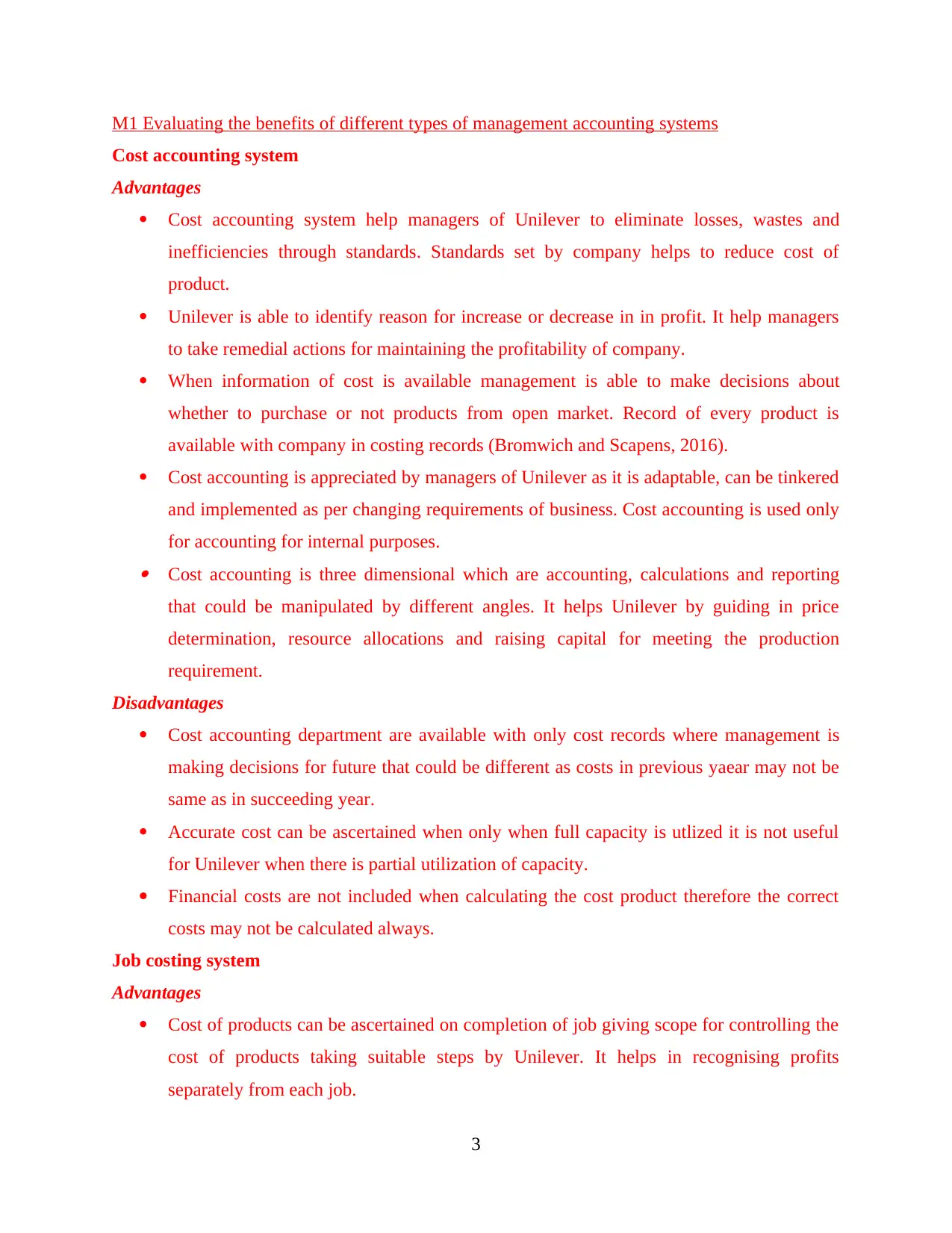
M1 Evaluating the benefits of different types of management accounting systems
Cost accounting system
Advantages
Cost accounting system help managers of Unilever to eliminate losses, wastes and
inefficiencies through standards. Standards set by company helps to reduce cost of
product.
Unilever is able to identify reason for increase or decrease in in profit. It help managers
to take remedial actions for maintaining the profitability of company.
When information of cost is available management is able to make decisions about
whether to purchase or not products from open market. Record of every product is
available with company in costing records (Bromwich and Scapens, 2016).
Cost accounting is appreciated by managers of Unilever as it is adaptable, can be tinkered
and implemented as per changing requirements of business. Cost accounting is used only
for accounting for internal purposes. Cost accounting is three dimensional which are accounting, calculations and reporting
that could be manipulated by different angles. It helps Unilever by guiding in price
determination, resource allocations and raising capital for meeting the production
requirement.
Disadvantages
Cost accounting department are available with only cost records where management is
making decisions for future that could be different as costs in previous yaear may not be
same as in succeeding year.
Accurate cost can be ascertained when only when full capacity is utlized it is not useful
for Unilever when there is partial utilization of capacity.
Financial costs are not included when calculating the cost product therefore the correct
costs may not be calculated always.
Job costing system
Advantages
Cost of products can be ascertained on completion of job giving scope for controlling the
cost of products taking suitable steps by Unilever. It helps in recognising profits
separately from each job.
3
Cost accounting system
Advantages
Cost accounting system help managers of Unilever to eliminate losses, wastes and
inefficiencies through standards. Standards set by company helps to reduce cost of
product.
Unilever is able to identify reason for increase or decrease in in profit. It help managers
to take remedial actions for maintaining the profitability of company.
When information of cost is available management is able to make decisions about
whether to purchase or not products from open market. Record of every product is
available with company in costing records (Bromwich and Scapens, 2016).
Cost accounting is appreciated by managers of Unilever as it is adaptable, can be tinkered
and implemented as per changing requirements of business. Cost accounting is used only
for accounting for internal purposes. Cost accounting is three dimensional which are accounting, calculations and reporting
that could be manipulated by different angles. It helps Unilever by guiding in price
determination, resource allocations and raising capital for meeting the production
requirement.
Disadvantages
Cost accounting department are available with only cost records where management is
making decisions for future that could be different as costs in previous yaear may not be
same as in succeeding year.
Accurate cost can be ascertained when only when full capacity is utlized it is not useful
for Unilever when there is partial utilization of capacity.
Financial costs are not included when calculating the cost product therefore the correct
costs may not be calculated always.
Job costing system
Advantages
Cost of products can be ascertained on completion of job giving scope for controlling the
cost of products taking suitable steps by Unilever. It helps in recognising profits
separately from each job.
3
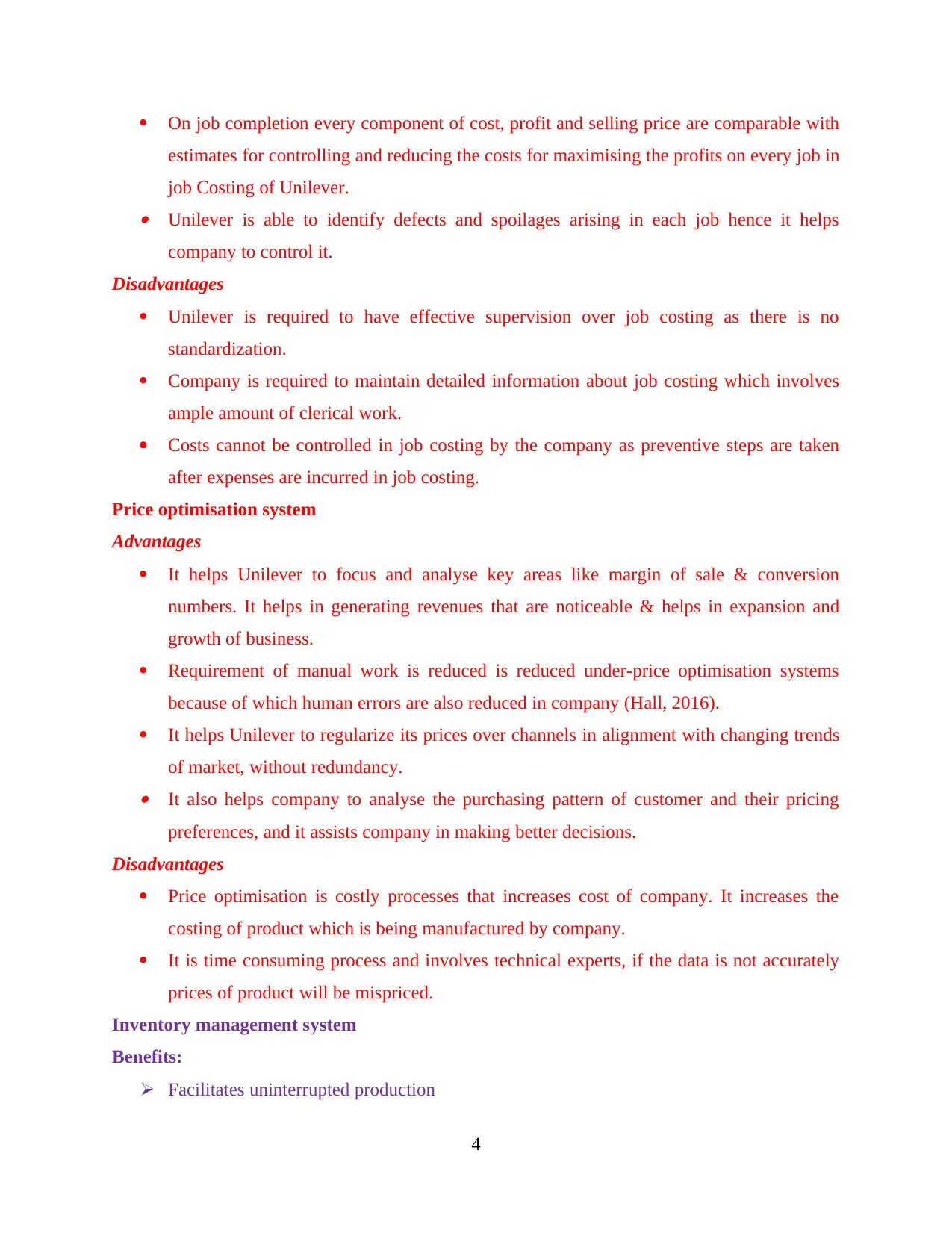
On job completion every component of cost, profit and selling price are comparable with
estimates for controlling and reducing the costs for maximising the profits on every job in
job Costing of Unilever. Unilever is able to identify defects and spoilages arising in each job hence it helps
company to control it.
Disadvantages
Unilever is required to have effective supervision over job costing as there is no
standardization.
Company is required to maintain detailed information about job costing which involves
ample amount of clerical work.
Costs cannot be controlled in job costing by the company as preventive steps are taken
after expenses are incurred in job costing.
Price optimisation system
Advantages
It helps Unilever to focus and analyse key areas like margin of sale & conversion
numbers. It helps in generating revenues that are noticeable & helps in expansion and
growth of business.
Requirement of manual work is reduced is reduced under-price optimisation systems
because of which human errors are also reduced in company (Hall, 2016).
It helps Unilever to regularize its prices over channels in alignment with changing trends
of market, without redundancy. It also helps company to analyse the purchasing pattern of customer and their pricing
preferences, and it assists company in making better decisions.
Disadvantages
Price optimisation is costly processes that increases cost of company. It increases the
costing of product which is being manufactured by company.
It is time consuming process and involves technical experts, if the data is not accurately
prices of product will be mispriced.
Inventory management system
Benefits:
Facilitates uninterrupted production
4
estimates for controlling and reducing the costs for maximising the profits on every job in
job Costing of Unilever. Unilever is able to identify defects and spoilages arising in each job hence it helps
company to control it.
Disadvantages
Unilever is required to have effective supervision over job costing as there is no
standardization.
Company is required to maintain detailed information about job costing which involves
ample amount of clerical work.
Costs cannot be controlled in job costing by the company as preventive steps are taken
after expenses are incurred in job costing.
Price optimisation system
Advantages
It helps Unilever to focus and analyse key areas like margin of sale & conversion
numbers. It helps in generating revenues that are noticeable & helps in expansion and
growth of business.
Requirement of manual work is reduced is reduced under-price optimisation systems
because of which human errors are also reduced in company (Hall, 2016).
It helps Unilever to regularize its prices over channels in alignment with changing trends
of market, without redundancy. It also helps company to analyse the purchasing pattern of customer and their pricing
preferences, and it assists company in making better decisions.
Disadvantages
Price optimisation is costly processes that increases cost of company. It increases the
costing of product which is being manufactured by company.
It is time consuming process and involves technical experts, if the data is not accurately
prices of product will be mispriced.
Inventory management system
Benefits:
Facilitates uninterrupted production
4
⊘ This is a preview!⊘
Do you want full access?
Subscribe today to unlock all pages.

Trusted by 1+ million students worldwide
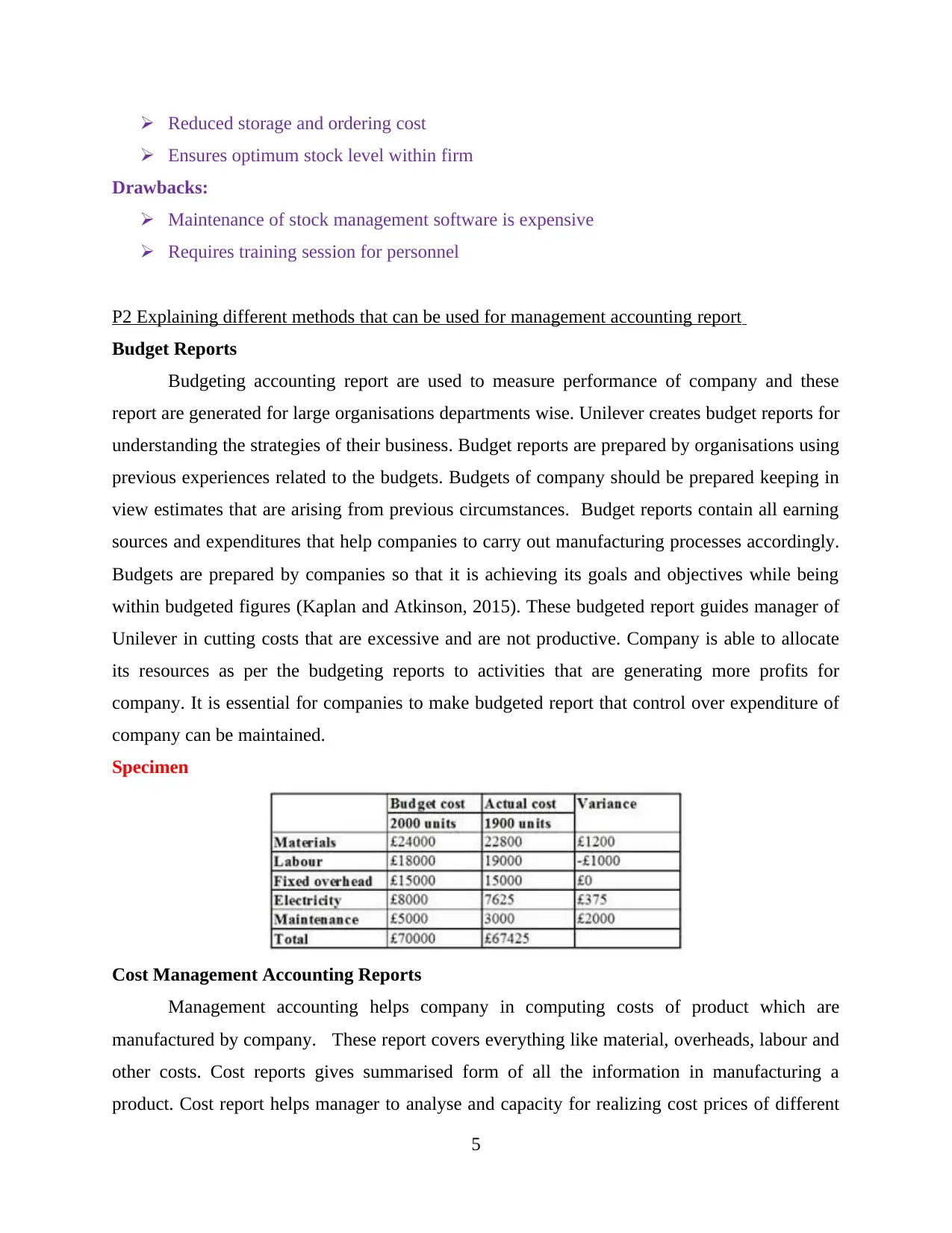
Reduced storage and ordering cost
Ensures optimum stock level within firm
Drawbacks:
Maintenance of stock management software is expensive
Requires training session for personnel
P2 Explaining different methods that can be used for management accounting report
Budget Reports
Budgeting accounting report are used to measure performance of company and these
report are generated for large organisations departments wise. Unilever creates budget reports for
understanding the strategies of their business. Budget reports are prepared by organisations using
previous experiences related to the budgets. Budgets of company should be prepared keeping in
view estimates that are arising from previous circumstances. Budget reports contain all earning
sources and expenditures that help companies to carry out manufacturing processes accordingly.
Budgets are prepared by companies so that it is achieving its goals and objectives while being
within budgeted figures (Kaplan and Atkinson, 2015). These budgeted report guides manager of
Unilever in cutting costs that are excessive and are not productive. Company is able to allocate
its resources as per the budgeting reports to activities that are generating more profits for
company. It is essential for companies to make budgeted report that control over expenditure of
company can be maintained.
Specimen
Cost Management Accounting Reports
Management accounting helps company in computing costs of product which are
manufactured by company. These report covers everything like material, overheads, labour and
other costs. Cost reports gives summarised form of all the information in manufacturing a
product. Cost report helps manager to analyse and capacity for realizing cost prices of different
5
Ensures optimum stock level within firm
Drawbacks:
Maintenance of stock management software is expensive
Requires training session for personnel
P2 Explaining different methods that can be used for management accounting report
Budget Reports
Budgeting accounting report are used to measure performance of company and these
report are generated for large organisations departments wise. Unilever creates budget reports for
understanding the strategies of their business. Budget reports are prepared by organisations using
previous experiences related to the budgets. Budgets of company should be prepared keeping in
view estimates that are arising from previous circumstances. Budget reports contain all earning
sources and expenditures that help companies to carry out manufacturing processes accordingly.
Budgets are prepared by companies so that it is achieving its goals and objectives while being
within budgeted figures (Kaplan and Atkinson, 2015). These budgeted report guides manager of
Unilever in cutting costs that are excessive and are not productive. Company is able to allocate
its resources as per the budgeting reports to activities that are generating more profits for
company. It is essential for companies to make budgeted report that control over expenditure of
company can be maintained.
Specimen
Cost Management Accounting Reports
Management accounting helps company in computing costs of product which are
manufactured by company. These report covers everything like material, overheads, labour and
other costs. Cost reports gives summarised form of all the information in manufacturing a
product. Cost report helps manager to analyse and capacity for realizing cost prices of different
5
Paraphrase This Document
Need a fresh take? Get an instant paraphrase of this document with our AI Paraphraser
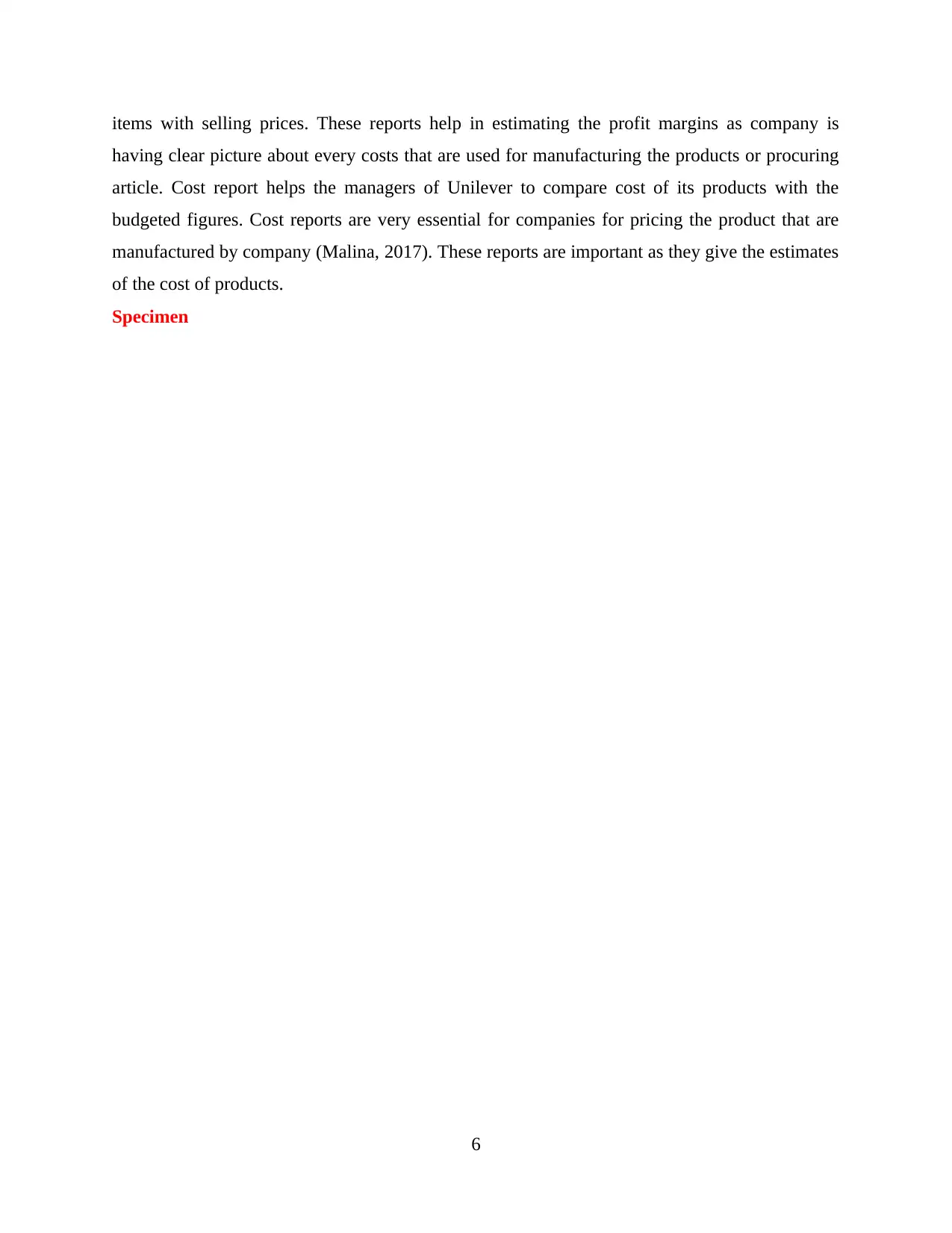
items with selling prices. These reports help in estimating the profit margins as company is
having clear picture about every costs that are used for manufacturing the products or procuring
article. Cost report helps the managers of Unilever to compare cost of its products with the
budgeted figures. Cost reports are very essential for companies for pricing the product that are
manufactured by company (Malina, 2017). These reports are important as they give the estimates
of the cost of products.
Specimen
6
having clear picture about every costs that are used for manufacturing the products or procuring
article. Cost report helps the managers of Unilever to compare cost of its products with the
budgeted figures. Cost reports are very essential for companies for pricing the product that are
manufactured by company (Malina, 2017). These reports are important as they give the estimates
of the cost of products.
Specimen
6
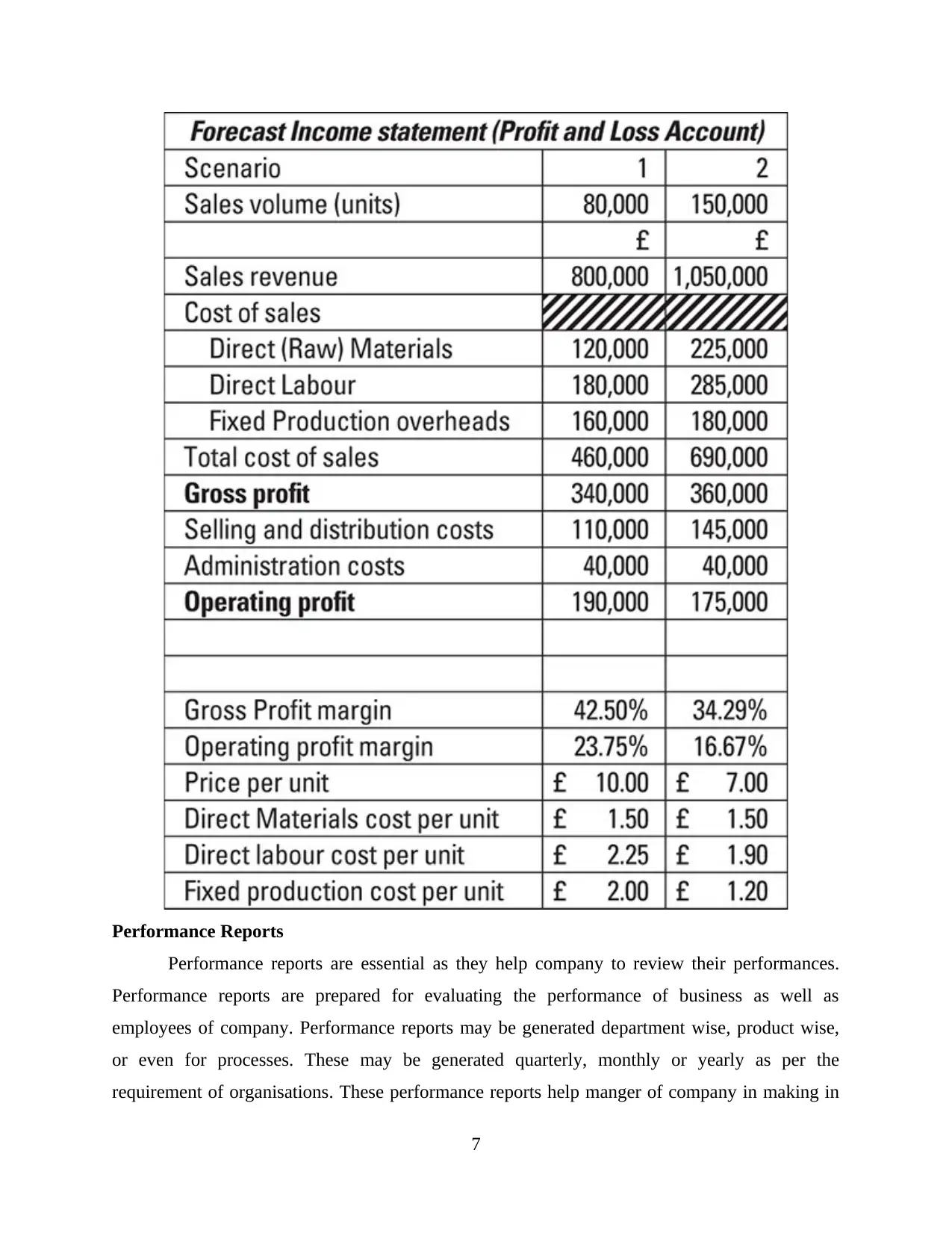
Performance Reports
Performance reports are essential as they help company to review their performances.
Performance reports are prepared for evaluating the performance of business as well as
employees of company. Performance reports may be generated department wise, product wise,
or even for processes. These may be generated quarterly, monthly or yearly as per the
requirement of organisations. These performance reports help manger of company in making in
7
Performance reports are essential as they help company to review their performances.
Performance reports are prepared for evaluating the performance of business as well as
employees of company. Performance reports may be generated department wise, product wise,
or even for processes. These may be generated quarterly, monthly or yearly as per the
requirement of organisations. These performance reports help manger of company in making in
7
⊘ This is a preview!⊘
Do you want full access?
Subscribe today to unlock all pages.

Trusted by 1+ million students worldwide
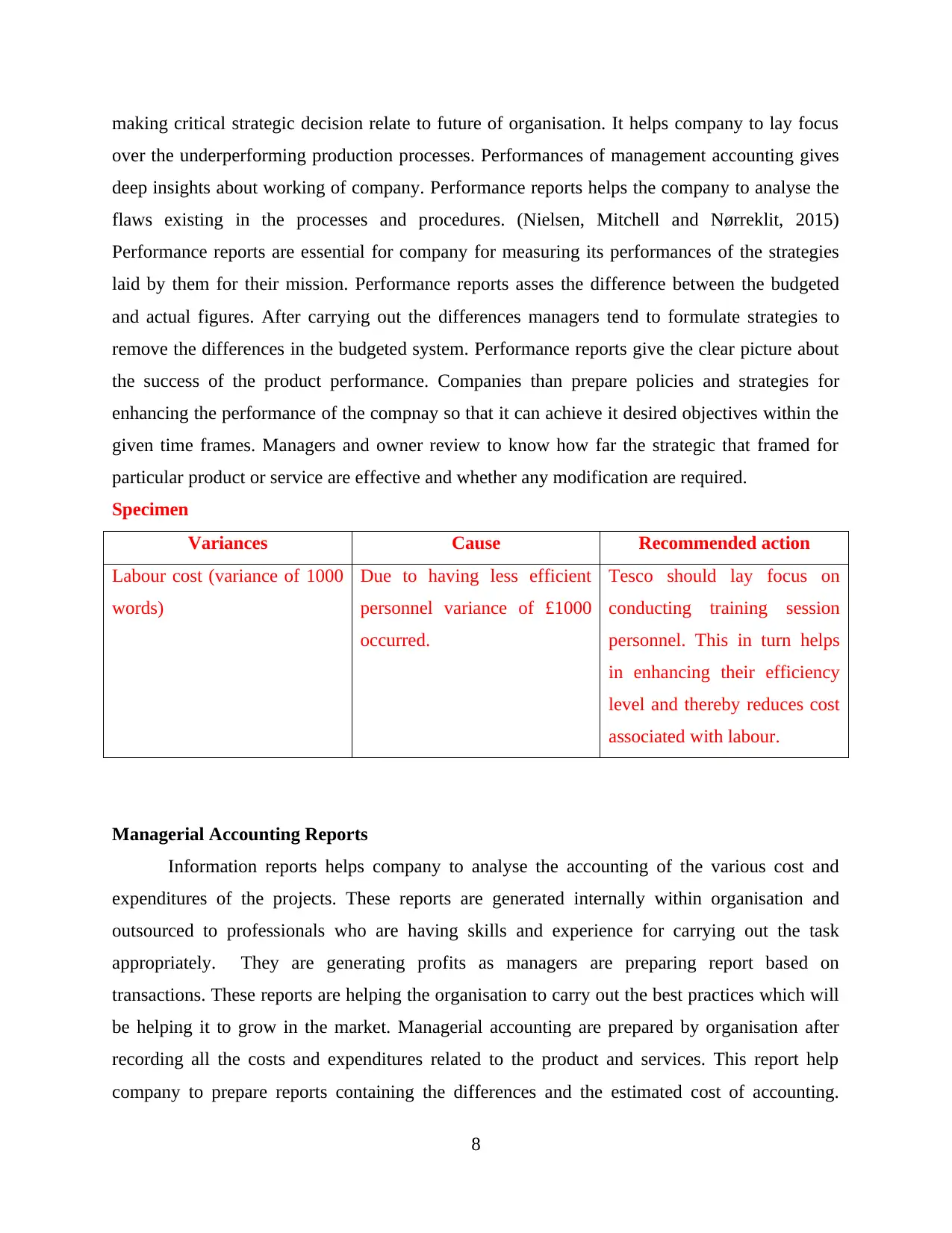
making critical strategic decision relate to future of organisation. It helps company to lay focus
over the underperforming production processes. Performances of management accounting gives
deep insights about working of company. Performance reports helps the company to analyse the
flaws existing in the processes and procedures. (Nielsen, Mitchell and Nørreklit, 2015)
Performance reports are essential for company for measuring its performances of the strategies
laid by them for their mission. Performance reports asses the difference between the budgeted
and actual figures. After carrying out the differences managers tend to formulate strategies to
remove the differences in the budgeted system. Performance reports give the clear picture about
the success of the product performance. Companies than prepare policies and strategies for
enhancing the performance of the compnay so that it can achieve it desired objectives within the
given time frames. Managers and owner review to know how far the strategic that framed for
particular product or service are effective and whether any modification are required.
Specimen
Variances Cause Recommended action
Labour cost (variance of 1000
words)
Due to having less efficient
personnel variance of £1000
occurred.
Tesco should lay focus on
conducting training session
personnel. This in turn helps
in enhancing their efficiency
level and thereby reduces cost
associated with labour.
Managerial Accounting Reports
Information reports helps company to analyse the accounting of the various cost and
expenditures of the projects. These reports are generated internally within organisation and
outsourced to professionals who are having skills and experience for carrying out the task
appropriately. They are generating profits as managers are preparing report based on
transactions. These reports are helping the organisation to carry out the best practices which will
be helping it to grow in the market. Managerial accounting are prepared by organisation after
recording all the costs and expenditures related to the product and services. This report help
company to prepare reports containing the differences and the estimated cost of accounting.
8
over the underperforming production processes. Performances of management accounting gives
deep insights about working of company. Performance reports helps the company to analyse the
flaws existing in the processes and procedures. (Nielsen, Mitchell and Nørreklit, 2015)
Performance reports are essential for company for measuring its performances of the strategies
laid by them for their mission. Performance reports asses the difference between the budgeted
and actual figures. After carrying out the differences managers tend to formulate strategies to
remove the differences in the budgeted system. Performance reports give the clear picture about
the success of the product performance. Companies than prepare policies and strategies for
enhancing the performance of the compnay so that it can achieve it desired objectives within the
given time frames. Managers and owner review to know how far the strategic that framed for
particular product or service are effective and whether any modification are required.
Specimen
Variances Cause Recommended action
Labour cost (variance of 1000
words)
Due to having less efficient
personnel variance of £1000
occurred.
Tesco should lay focus on
conducting training session
personnel. This in turn helps
in enhancing their efficiency
level and thereby reduces cost
associated with labour.
Managerial Accounting Reports
Information reports helps company to analyse the accounting of the various cost and
expenditures of the projects. These reports are generated internally within organisation and
outsourced to professionals who are having skills and experience for carrying out the task
appropriately. They are generating profits as managers are preparing report based on
transactions. These reports are helping the organisation to carry out the best practices which will
be helping it to grow in the market. Managerial accounting are prepared by organisation after
recording all the costs and expenditures related to the product and services. This report help
company to prepare reports containing the differences and the estimated cost of accounting.
8
Paraphrase This Document
Need a fresh take? Get an instant paraphrase of this document with our AI Paraphraser
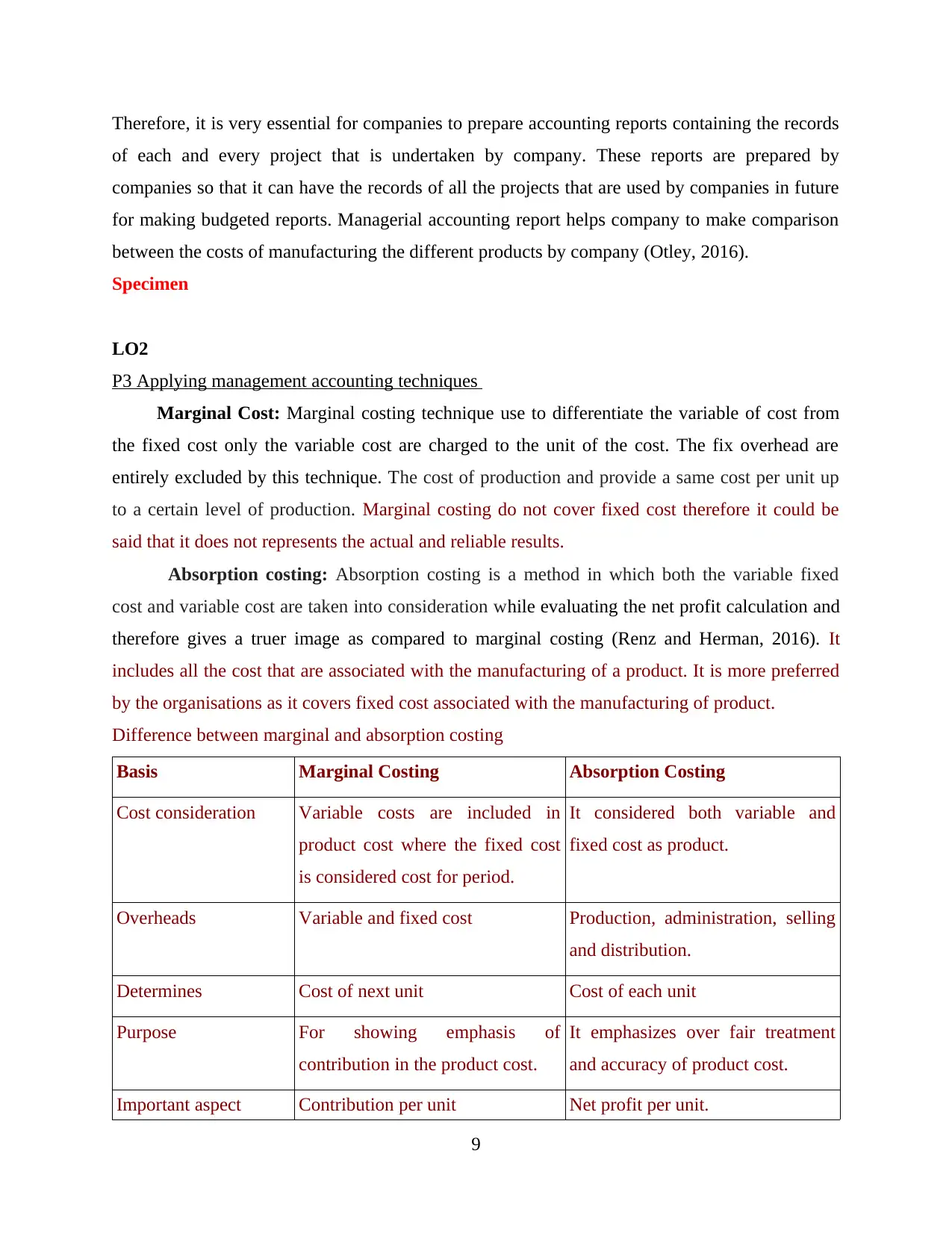
Therefore, it is very essential for companies to prepare accounting reports containing the records
of each and every project that is undertaken by company. These reports are prepared by
companies so that it can have the records of all the projects that are used by companies in future
for making budgeted reports. Managerial accounting report helps company to make comparison
between the costs of manufacturing the different products by company (Otley, 2016).
Specimen
LO2
P3 Applying management accounting techniques
Marginal Cost: Marginal costing technique use to differentiate the variable of cost from
the fixed cost only the variable cost are charged to the unit of the cost. The fix overhead are
entirely excluded by this technique. The cost of production and provide a same cost per unit up
to a certain level of production. Marginal costing do not cover fixed cost therefore it could be
said that it does not represents the actual and reliable results.
Absorption costing: Absorption costing is a method in which both the variable fixed
cost and variable cost are taken into consideration while evaluating the net profit calculation and
therefore gives a truer image as compared to marginal costing (Renz and Herman, 2016). It
includes all the cost that are associated with the manufacturing of a product. It is more preferred
by the organisations as it covers fixed cost associated with the manufacturing of product.
Difference between marginal and absorption costing
Basis Marginal Costing Absorption Costing
Cost consideration Variable costs are included in
product cost where the fixed cost
is considered cost for period.
It considered both variable and
fixed cost as product.
Overheads Variable and fixed cost Production, administration, selling
and distribution.
Determines Cost of next unit Cost of each unit
Purpose For showing emphasis of
contribution in the product cost.
It emphasizes over fair treatment
and accuracy of product cost.
Important aspect Contribution per unit Net profit per unit.
9
of each and every project that is undertaken by company. These reports are prepared by
companies so that it can have the records of all the projects that are used by companies in future
for making budgeted reports. Managerial accounting report helps company to make comparison
between the costs of manufacturing the different products by company (Otley, 2016).
Specimen
LO2
P3 Applying management accounting techniques
Marginal Cost: Marginal costing technique use to differentiate the variable of cost from
the fixed cost only the variable cost are charged to the unit of the cost. The fix overhead are
entirely excluded by this technique. The cost of production and provide a same cost per unit up
to a certain level of production. Marginal costing do not cover fixed cost therefore it could be
said that it does not represents the actual and reliable results.
Absorption costing: Absorption costing is a method in which both the variable fixed
cost and variable cost are taken into consideration while evaluating the net profit calculation and
therefore gives a truer image as compared to marginal costing (Renz and Herman, 2016). It
includes all the cost that are associated with the manufacturing of a product. It is more preferred
by the organisations as it covers fixed cost associated with the manufacturing of product.
Difference between marginal and absorption costing
Basis Marginal Costing Absorption Costing
Cost consideration Variable costs are included in
product cost where the fixed cost
is considered cost for period.
It considered both variable and
fixed cost as product.
Overheads Variable and fixed cost Production, administration, selling
and distribution.
Determines Cost of next unit Cost of each unit
Purpose For showing emphasis of
contribution in the product cost.
It emphasizes over fair treatment
and accuracy of product cost.
Important aspect Contribution per unit Net profit per unit.
9
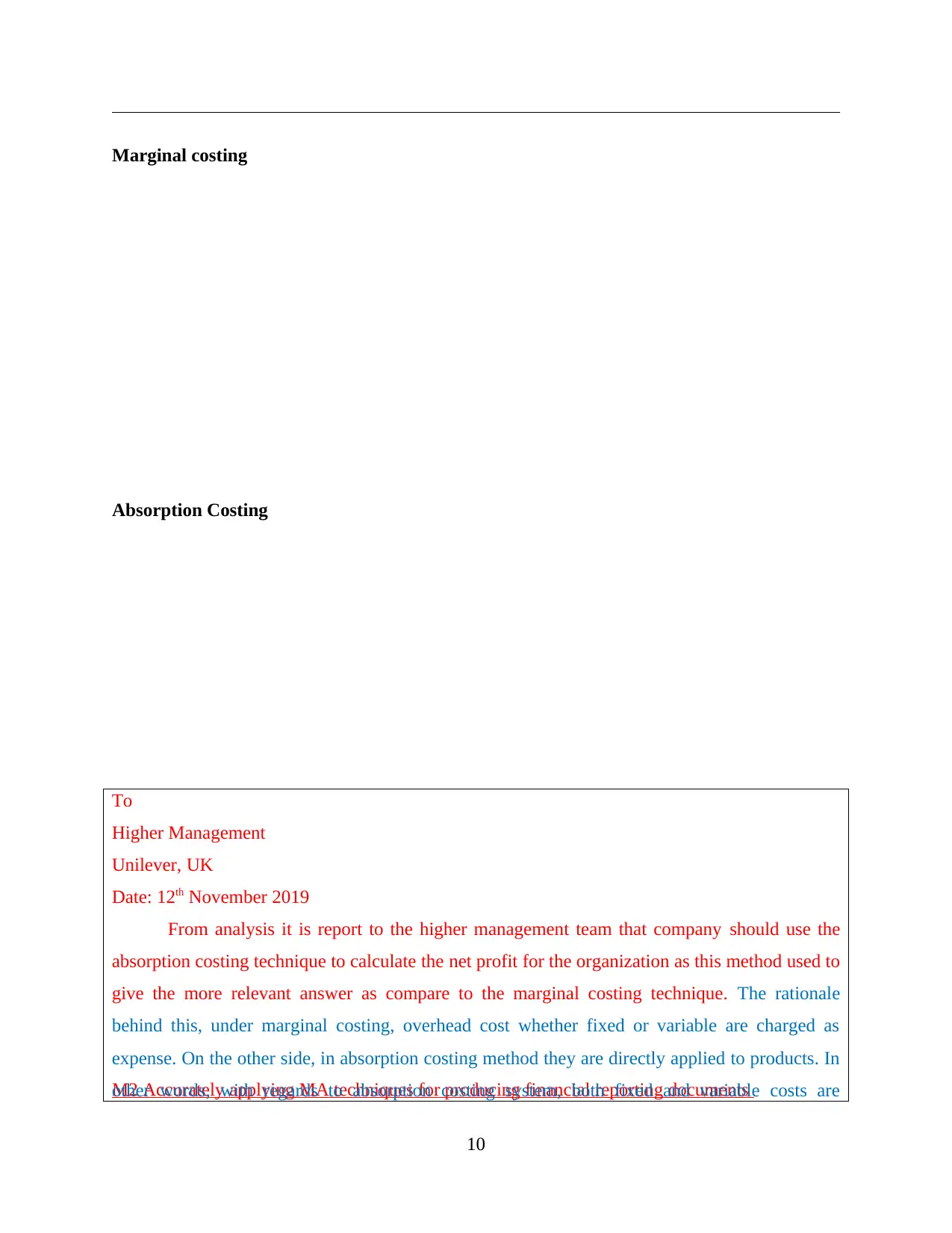
Marginal costing
Absorption Costing
M2 Accurately applying MA techniques for producing financial reporting documents
To
Higher Management
Unilever, UK
Date: 12th November 2019
From analysis it is report to the higher management team that company should use the
absorption costing technique to calculate the net profit for the organization as this method used to
give the more relevant answer as compare to the marginal costing technique. The rationale
behind this, under marginal costing, overhead cost whether fixed or variable are charged as
expense. On the other side, in absorption costing method they are directly applied to products. In
other words, with regards to absorption costing system, both fixed and variable costs are
10
Absorption Costing
M2 Accurately applying MA techniques for producing financial reporting documents
To
Higher Management
Unilever, UK
Date: 12th November 2019
From analysis it is report to the higher management team that company should use the
absorption costing technique to calculate the net profit for the organization as this method used to
give the more relevant answer as compare to the marginal costing technique. The rationale
behind this, under marginal costing, overhead cost whether fixed or variable are charged as
expense. On the other side, in absorption costing method they are directly applied to products. In
other words, with regards to absorption costing system, both fixed and variable costs are
10
⊘ This is a preview!⊘
Do you want full access?
Subscribe today to unlock all pages.

Trusted by 1+ million students worldwide
1 out of 24
Related Documents
Your All-in-One AI-Powered Toolkit for Academic Success.
+13062052269
info@desklib.com
Available 24*7 on WhatsApp / Email
![[object Object]](/_next/static/media/star-bottom.7253800d.svg)
Unlock your academic potential
Copyright © 2020–2025 A2Z Services. All Rights Reserved. Developed and managed by ZUCOL.





